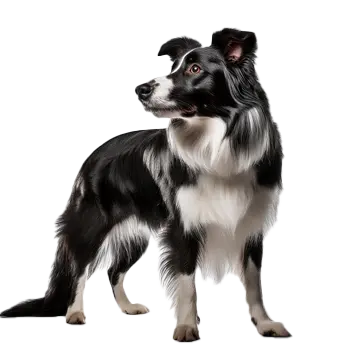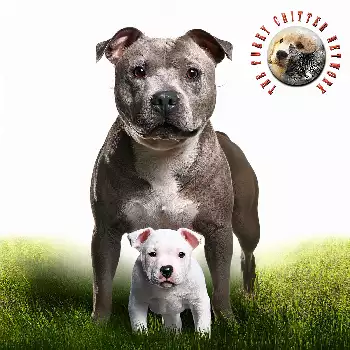Border Collie Bull Staffy
Hybrid Breed Description
The Border Collie Bull Staffy is a cross between the Border Collie and the Staffordshire Bull Terrier. Because each hybrid inherits a unique combination of traits from both parents, we recommend thoroughly researching both breeds before choosing a Border Collie Bull Staffy. Pay special attention to temperament, health issues, and care requirements, as your dog may express characteristics from either parent breed.
Border Collie

Border Collies are athletic medium-sized dogs standing between eighteen and twenty-two inches at the shoulder and weighing thirty to forty-five pounds. Males typically reach the upper end of this range while females are slightly smaller, creating an agile, well-proportioned frame built for stamina and speed. Their body is slightly longer than tall, with a lean yet muscular build that reflects generations of herding work across rugged terrain. The breed possesses straight, strong legs with well-boned structure and a deep chest that provides excellent lung capacity for sustained activity. Their shoulders are well laid back, contributing to their flowing, effortless gait that allows them to cover ground efficiently while maintaining balance and control. Their distinctive coat comes in two varieties: smooth and rough. Both types feature a dense double coat designed to protect against harsh weather conditions and resist water absorption. The rough coat is medium-length with feathering on the legs, chest, and tail, while the smooth coat is shorter and coarser but equally weather-resistant. Color patterns are remarkably diverse, though black and white is most recognizable and commonly seen. Other combinations include red and white, blue merle, red merle, tricolor patterns with black, white and tan markings, sable, and brindle variations. Some dogs display solid colors or predominantly white coats, though these are less common. The breed's coloring does not affect working ability, as function has always been prioritized over appearance in traditional working lines. The head is proportionate with a distinctive collie-like appearance and an alert, intelligent expression enhanced by their keen, watchful eyes that may be brown, blue, or even heterochromatic in merle-colored dogs. Their ears stand erect or semi-erect with tips that often fold over, creating a characteristic jaunty look that adds to their attentive appearance. The muzzle is of medium length with a moderate stop, and the skull is fairly broad. The tail is moderately long, set low, and carried with an upward swirl especially when the dog is alert or working. Their overall appearance conveys focused intensity combined with remarkable athleticism, grace, and an unmistakable readiness for action.
Key Characteristics
Border Collies consistently rank among the most intelligent dog breeds in the world, possessing an extraordinary capacity to learn commands quickly and solve complex problems with minimal repetition. This remarkable intelligence requires substantial mental stimulation daily, as boredom can quickly lead to destructive behaviors including excessive barking, digging, and inappropriate chewing. They excel at learning tricks, competing in dog sports such as agility and obedience trials, and responding to subtle handler cues including whistles, hand signals, body language, and even raised eyebrows. Their working heritage means they approach tasks with intense focus, determination, and what many owners describe as an almost obsessive dedication to completing jobs. Highly energetic and driven by instinct, Border Collies were bred to work long hours herding sheep across demanding terrain in all weather conditions. They possess seemingly boundless stamina and require extensive daily exercise that goes far beyond simple neighborhood walks. Without adequate physical and mental activity provided through structured exercise, training sessions, or dog sports, they may develop problematic behaviors including excessive barking, digging, escaping, or inappropriate herding of children, other pets, and even passing vehicles. Their herding instinct remains powerful and ever-present, causing them to circle family members, stare intensely at moving objects, and nip at heels to control movement. Despite their intense work drive and high energy levels, Border Collies form extraordinarily deep bonds with their families and display remarkable loyalty, affection, and devotion. They are sensitive dogs that respond poorly to harsh corrections or punitive training methods, thriving instead with positive reinforcement, consistency, and patience. While they can be reserved or aloof with strangers, proper early socialization helps prevent excessive shyness or wariness. They typically coexist well with children and other pets when raised together from puppyhood, though their strong herding instincts always require careful management and supervision.
Border Collies are generally healthy dogs with a typical lifespan of twelve to fifteen years when provided with proper care, though they are predisposed to certain genetic conditions that prospective owners should understand. Hip dysplasia is a significant concern within the breed, where abnormal hip joint development leads to joint laxity, arthritis, and progressive mobility issues over time. Elbow dysplasia can also occur with similar frequency, causing lameness and pain in the front legs. Responsible breeders screen parent dogs for these orthopedic conditions through radiographic evaluation, and maintaining appropriate weight through proper diet combined with controlled exercise helps manage symptoms and slow progression. The breed faces several hereditary eye conditions requiring vigilant attention and regular screening. Collie Eye Anomaly affects retinal development and ranges in severity from mild vision impairment to complete blindness, though fortunately it is non-progressive and does not worsen over time. Progressive Retinal Atrophy causes gradual degeneration and vision loss potentially leading to complete blindness, typically manifesting first as night blindness. Other eye concerns include hereditary cataracts that can develop at any age and lens luxation where supporting ligaments break down. Regular comprehensive ophthalmologic examinations help detect these issues early, and genetic testing allows breeders to make informed breeding decisions to reduce incidence. Neurological conditions also affect the breed with notable frequency. Epilepsy is relatively common, with seizures typically beginning between six months and three years of age and requiring lifelong medication management with periodic blood work monitoring. Border Collie Collapse is a breed-specific exercise-induced condition causing temporary loss of coordination, consciousness, and muscle control during or after intense activity. Additional health considerations include Trapped Neutrophil Syndrome affecting immune system function, Neuronal Ceroid Lipofuscinosis causing degenerative neurological decline, and occasional cases of hypothyroidism. Comprehensive preventive care through regular veterinary check-ups, appropriate genetic health testing of breeding stock, and maintaining healthy weight and fitness levels significantly contributes to longevity and quality of life.
Staffordshire Bull Terrier

Staffordshire Bull Terriers are powerfully built medium-sized dogs standing fourteen to sixteen inches tall at the shoulder and weighing between twenty-eight and thirty-eight pounds for males, with females being slightly smaller at twenty-four to thirty-four pounds. Despite their compact stature, they pack considerable muscle mass into their frames, creating an unmistakable impression of being much larger and more imposing than their actual measurements suggest. The body is relatively wide and slightly longer than tall, providing a low center of gravity that enhances stability, power, and the ability to maintain balance during quick movements and direction changes. Their build reflects generations of selective breeding for strength and tenacity. Their most visually striking features are the massive muscles particularly visible across the shoulders and hindquarters, the exceptionally broad chest that provides lung capacity, and the distinctively wide, powerful jaws capable of tremendous bite force. The head is short, broad, and deep with extremely pronounced cheek muscles that create their characteristic appearance. Despite this formidable, imposing look that can seem intimidating to those unfamiliar with the breed, Staffords are surprisingly agile, quick on their feet, and capable of remarkable athletic feats including jumping, sprinting, and rapid directional changes. Their ears are small, fold over naturally at the tips in a rose or half-prick style, and are never cropped. The neck is short, thick, and heavily muscled, contributing to their confident, powerful stance and overall appearance of strength. The coat is short, smooth, glossy, and stiff to the touch, lying close to the skin and requiring only minimal grooming maintenance. Color variations include red, fawn, white, black, blue, various shades of brindle creating striped patterns, or any of these solid colors combined with white markings in different patterns. The tail is medium length, set relatively low, and carried without excessive curl above the back. Their eyes are round, dark, and expressive, though lighter eye colors may appear in dogs with lighter coat colors. The overall physical appearance projects undeniable strength, determination, and athletic capability while their facial expression often reveals their gentle, affectionate, people-loving nature that has earned them the affectionate nickname nanny dog throughout their native England due to their renowned patience and gentleness with children.
Key Characteristics
Staffordshire Bull Terriers are profoundly affectionate, intensely people-oriented dogs that thrive on constant human companionship and form exceptionally strong, unbreakable bonds with their families that define their entire existence. Known particularly for their extraordinary love of children, they display remarkable patience, gentleness, and tolerance despite their tough, muscular exterior that can mislead those unfamiliar with the breed. They desire and require constant involvement in all family activities, becoming anxious, stressed, or destructive when left alone for extended periods without adequate attention and interaction. Their enthusiastic greetings typically involve exuberant jumping, vigorous tail wagging, and enthusiastic face licking, reflecting their genuine joy and excitement at being with their beloved people. Highly intelligent, quick to learn, and genuinely trainable, Staffords pick up new commands and behaviors quickly but can display notable stubbornness requiring patient, consistent training emphasizing rewards and praise. They respond exceptionally well to game-based training approaches and positive reinforcement but react poorly to harsh corrections or punitive methods, which severely damage their sensitive nature. Their courage and tenacity from their historical background remain present but have been significantly tempered through decades of careful selective breeding emphasizing gentle, playful, family-oriented qualities. While generally friendly with proper socialization, they may not always get along with unfamiliar dogs due to their strong terrier heritage and high prey drive. Energy levels are consistently high throughout their lives, requiring substantial daily exercise and engaging mental stimulation to prevent boredom-related problems including destructive chewing and excessive barking. They excel at various dog sports including agility competitions, obedience trials, weight pulling events, and flyball, effectively channeling their considerable strength and intelligence into productive activities.
Staffordshire Bull Terriers have a typical lifespan of twelve to fourteen years and are generally healthy overall, though predisposed to certain genetic conditions requiring awareness. Hip dysplasia affects approximately sixteen percent of tested individuals, where abnormal hip joint development causes progressive pain and arthritis significantly impacting mobility. Elbow dysplasia is also prevalent, affecting nearly nineteen percent of tested dogs with similar painful challenges. Both conditions benefit from maintaining healthy weight through portion-controlled feeding and controlled exercise programs, potentially requiring surgical intervention in severe cases. Eye conditions pose significant concerns requiring vigilant monitoring. Hereditary cataracts affect approximately eight percent of Staffords, potentially progressing toward complete blindness without timely surgical treatment. Persistent Hyperplastic Primary Vitreous represents another inherited eye condition that can impair vision. Regular comprehensive ophthalmologic examinations combined with genetic testing help identify affected individuals and carriers. Additional eye issues include Progressive Retinal Atrophy and juvenile cataracts that may manifest early in life, sometimes before one year of age. Neurological disorders include epilepsy causing recurrent seizures and L-2-Hydroxyglutaric Aciduria, a rare inherited metabolic condition affecting brain and spinal cord function, typically appearing in puppies with symptoms including seizures and tremors. Genetic testing identifies carriers and affected individuals, allowing informed breeding decisions. Skin allergies are extremely common, triggered by environmental factors, food sensitivities, or parasites, causing intense itching and potential infections. The breed shows notable predisposition to obesity which exacerbates joint problems. Additional concerns include patellar luxation, heart disease, brachycephalic syndrome, and demodectic mange.
Important to Remember
Each hybrid dog is unique and may inherit any combination of traits from either parent breed. The information above represents the characteristics of the purebred parent breeds. Your Border Collie Bull Staffy may favor one parent over the other or display a blend of both. We strongly encourage you to read the complete breed profiles for both the Border Collie and Staffordshire Bull Terrier to fully understand the range of possible temperaments, health concerns, and care requirements.